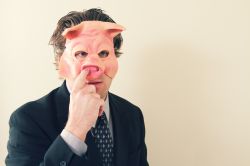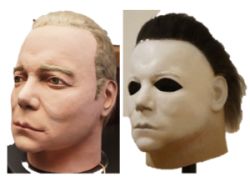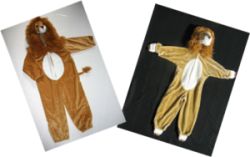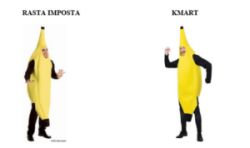- within Media, Telecoms, IT, Entertainment and Tax topic(s)
 This is a tough time of year if you
are an intellectual property lawyer who likes to dress up. Anyone
who knows about your job will be unable to resist lame and legally
incorrect jokes about your Halloween costume. If you wear a Mohawk
wig, they will quip that you are infringing Mr. T's copyright.
If you wield a sword and don a fur coat, they will ask if you had
permission to use the "patent" from Game of
Thrones.
This is a tough time of year if you
are an intellectual property lawyer who likes to dress up. Anyone
who knows about your job will be unable to resist lame and legally
incorrect jokes about your Halloween costume. If you wear a Mohawk
wig, they will quip that you are infringing Mr. T's copyright.
If you wield a sword and don a fur coat, they will ask if you had
permission to use the "patent" from Game of
Thrones.
How do you respond? Do you engage in sophisticated badinage about the doubtful copyrightability of an unoriginal hairstyle? Do you tell them that patent and copyright are two different things? Do you explain that trademark infringement is a more likely... no; waste of time. Instead, why not respond with some real facts about Halloween costume copyrights? Here are five things you should know:
1. The Useful Article Doctrine Applies to Costumes . . .
 When litigation over allegedly pirated
Halloween costumes first started bubbling up in the late
1980's, the courts turned to the "useful article
doctrine," which embodies Congress' intent to exclude
functional industrial design from the Copyright Act. A useful
article is defined under 17 U.S.C. § 101 as an item with "an
intrinsic utilitarian function that is not merely to portray the
appearance of the article or to convey information." Useful
articles don't get copyright protection, which means that, for
the most part, you can't own a copyright in, say, the shape of
an automobile or a television set.
When litigation over allegedly pirated
Halloween costumes first started bubbling up in the late
1980's, the courts turned to the "useful article
doctrine," which embodies Congress' intent to exclude
functional industrial design from the Copyright Act. A useful
article is defined under 17 U.S.C. § 101 as an item with "an
intrinsic utilitarian function that is not merely to portray the
appearance of the article or to convey information." Useful
articles don't get copyright protection, which means that, for
the most part, you can't own a copyright in, say, the shape of
an automobile or a television set.
The useful article doctrine also applies to clothing (excluding the two-dimensional pattern of the fabric). In general, there is no copyright protection for the shape of clothing, and that includes costumes. For example, the Eastern District of New York, in Whimsicality, Inc. v. Rubie's Costumes, held that a children's costume with a torso in the shape of a pumpkin was a useful article because it was essentially just clothing. Sure, costumes are a specialized type of clothing, but that specialization also serves a purpose inseparable from the costume's appearance: the purpose of masquerading. The Copyright Office agreed and, in 1991, issued a Policy Decision on the Registrability of Costume Designs, which stated that "fanciful costumes will be treated as useful articles" generally not subject to copyright protection because they "serve a dual purpose of clothing the body and portraying their appearance."
2. . . . but not Masks
 Masks, as opposed to body costumes,
are not useful articles. In Masquerade Novelty v. Unique
Industries, the Eastern District of Pennsylvania
held (incorrectly) that masks configured to resemble the noses of a
pig, elephant and parrot were useful articles because they served
the "utilitarian purpose of allowing a person to create humor
by masquerading in an animal's nose." The Third Circuit
disagreed, holding that the function of the masks was "merely
to portray the appearance" of something. Therefore, they did
not fall within the definition of "useful article." The
Copyright Office followed the Third Circuit's lead, and advised that, "since masks generally
portray their own appearance, this subject matter appears to fall
outside the definition of 'useful article.'"
Masks, as opposed to body costumes,
are not useful articles. In Masquerade Novelty v. Unique
Industries, the Eastern District of Pennsylvania
held (incorrectly) that masks configured to resemble the noses of a
pig, elephant and parrot were useful articles because they served
the "utilitarian purpose of allowing a person to create humor
by masquerading in an animal's nose." The Third Circuit
disagreed, holding that the function of the masks was "merely
to portray the appearance" of something. Therefore, they did
not fall within the definition of "useful article." The
Copyright Office followed the Third Circuit's lead, and advised that, "since masks generally
portray their own appearance, this subject matter appears to fall
outside the definition of 'useful article.'"
3. Halloween Serial Killer Michael Meyers is really William Shatner
 One more thing to remember about masks.
Even though they are not useful articles and may qualify for
copyright protection, they still have to be original enough to get
that protection. In Don Post Studios v. Cinema
Secrets, another Eastern District of Pennsylvania
case, the makers of the Halloween movies were sued by the
guy that created that creepy mask worn by deranged killer Michael
Myers. The mask maker claimed that his creation was protected by
copyright, but the Court rejected this argument, in part because
the mask was just a mold of actor William Shatner's head
(originally created by the plaintiff for a Captain Kirk mask), and
therefore it was not a sufficiently original work of
authorship.
One more thing to remember about masks.
Even though they are not useful articles and may qualify for
copyright protection, they still have to be original enough to get
that protection. In Don Post Studios v. Cinema
Secrets, another Eastern District of Pennsylvania
case, the makers of the Halloween movies were sued by the
guy that created that creepy mask worn by deranged killer Michael
Myers. The mask maker claimed that his creation was protected by
copyright, but the Court rejected this argument, in part because
the mask was just a mold of actor William Shatner's head
(originally created by the plaintiff for a Captain Kirk mask), and
therefore it was not a sufficiently original work of
authorship.
4. Separability and the Disappearing Compendium Passage
 Even though costumes as a whole are
useful articles, the individual components of a costume can still
merit copyright protection if they are physically or conceptually
separable from the utilitarian aspects of the costume. For example,
in Chosun International v. Chrisha Creations, the maker of
animal costumes for children, featuring plush sculpted hoods and
sleeves shaped like paws, sued a competitor for using the same
design. The Second Circuit held that, although the costumes were
useful articles, the head and paws may be separable:
Even though costumes as a whole are
useful articles, the individual components of a costume can still
merit copyright protection if they are physically or conceptually
separable from the utilitarian aspects of the costume. For example,
in Chosun International v. Chrisha Creations, the maker of
animal costumes for children, featuring plush sculpted hoods and
sleeves shaped like paws, sued a competitor for using the same
design. The Second Circuit held that, although the costumes were
useful articles, the head and paws may be separable:
It might, for example, be the case that the sculpted "heads" of these designs are physically separable from the overall costume, in that they could be removed from the costume without adversely impacting the wearer's ability to cover his or her body. Similarly, it could be that the sculpted "heads" (and perhaps "hands") are conceptually separable. That is, Chosun may be able to show that they invoke in the viewer a concept separate from that of the costume's "clothing" function, and that their addition to the costume was not motivated by a desire to enhance the costume's functionality qua clothing.
Beware, however, because Copyright Office's test for Halloween costume separability may be in flux. In the 2014 version of the Copyright Compendium, the Copyright Office included a whole section on costumes (Section 924.3(A)(2)), which was based on the case law up to that point and provided an example similar to the Chosun case. However, in April 2017, the Supreme Court issued its opinion in Star Athletica v. Varsity Brands, which contained a new articulation of the separability analysis as applied to cheerleader uniforms (you can read about that case on our blog here). When a new version of the Copyright Compendium came out a few months later, the costume section had disappeared, replaced by a holding statement promising updated guidance in the wake of the Supreme Court decision.
5. Sadly, the Banana Case Settled
 We copyright nerds got super excited
about a month ago when costume maker Rasta Imposta sued Kmart in
the District of New Jersey for over an alleged
"knock-off" banana costume. (I was especially excited,
because I was wearing banana costumes before they were cool.)
We copyright nerds got super excited
about a month ago when costume maker Rasta Imposta sued Kmart in
the District of New Jersey for over an alleged
"knock-off" banana costume. (I was especially excited,
because I was wearing banana costumes before they were cool.)
So many questions could have been answered by this case. What is the impact of Star Athletica on costume copyrights? Is the banana shape separable from the utilitarian costume or is it just a piece of clothing? What about Judge Posner's 2012 dicta in the Banana Lady case, in which he expressed doubt "about the validity of [a banana costume] copyright because banana costumes quite similar to hers are, we are surprised to discover, a common consumer product."
Sadly, we may never find out the answers to these questions, because the case settled earlier this month, just in time for Halloween.
To view Foley Hoag's Trademark and Copyright Law Blog please click here
The content of this article is intended to provide a general guide to the subject matter. Specialist advice should be sought about your specific circumstances.


